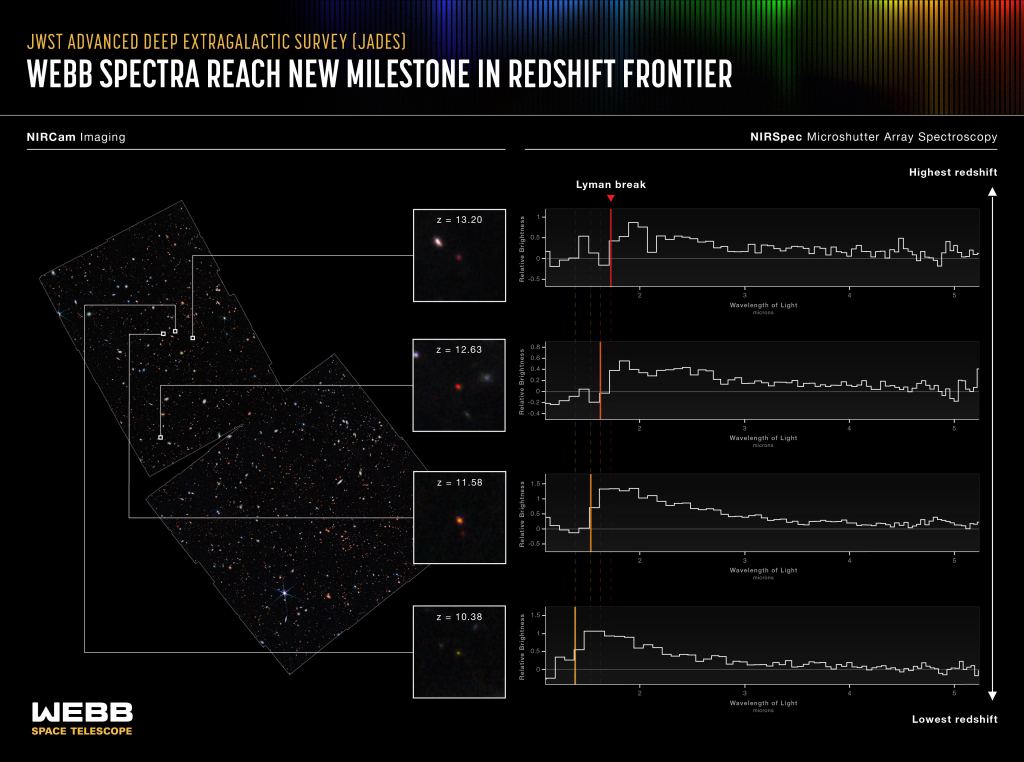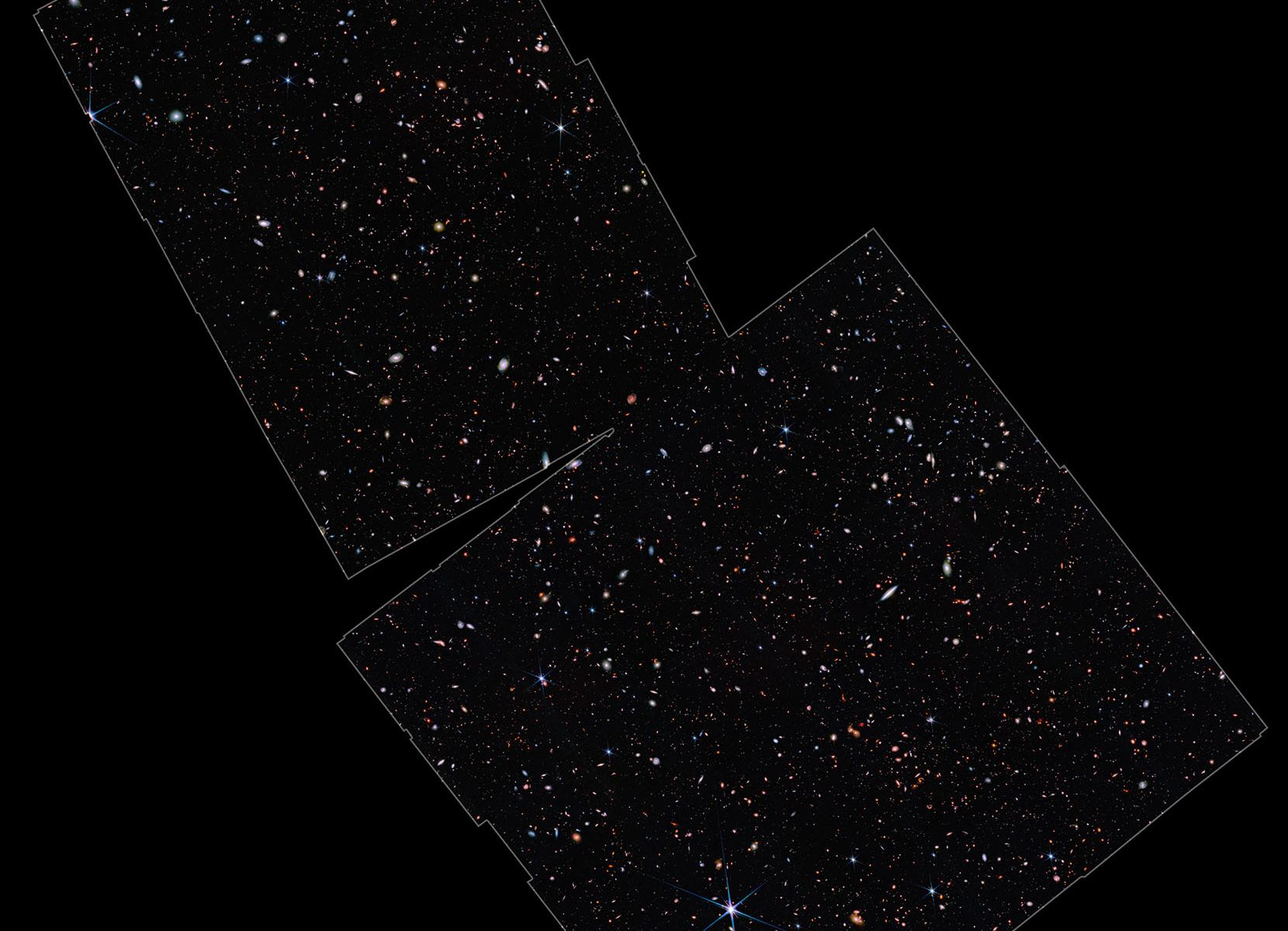About 13 billion years ago, the stars in the Universe’s earliest galaxies sent photons out into space. Some of those photons ended their epic journey on the James Webb Space Telescope’s gold-plated, beryllium mirrors in the last few months. The JWST gathered these primordial photons over several days to create its first “Deep Field” image.
One of the JWST’s primary objectives is to study the Universe’s first galaxies. The results will help astrophysicists piece together the Universe’s history and how galaxies evolved. These early galaxies are extremely faint, but JWST was built to find them.
“So many questions about galaxies have been waiting for the transformative opportunity of Webb, and we’re thrilled to be able to play a part in revealing this story.”
Sandro Tacchella, astronomer, University of Cambridge, United Kingdom
Many things in nature masquerade as something else. Only after scientists apply their skills do we approach the truth. Early thinkers thought that everything in the Universe revolved around Earth, placing humanity at the center of everything, a confounding misapprehension that still befuddles humankind to this day. Eventually, we figured it out, thanks to Copernicus and those that followed. Natural features on Mars looked like canals built by a Martian civilization, getting everyone excited and even fooling some scientists. Eventually, better telescopes revealed the truth. There are endless examples of this.
Younger galaxies can masquerade as ancient galaxies, a problem that has plagued our attempts to understand the evolution of galaxies. The early Universe was almost entirely made of two lightest, simplest elements, hydrogen and helium. As a result, the stars that comprise the earliest galaxies are made almost entirely of hydrogen and helium. They have “low metallicity” in astronomical jargon.
Confusingly, some younger galaxies also have low metallicity. They should have much more than just hydrogen and helium in them because so many stars lived and died before these galaxies formed. And stars are what forge heavier elements, sending them out into space when they die to be taken up by the next generation of stars.
But the JWST isn’t easily fooled.

The JWST can more precisely dissect the light from these galaxies than any of its predecessors. It needs to be kept ultra-cold to observe infrared light in such detail, which is why it sits way out in space, sheltered by a massive sun shield. The JWST’s Near-Infrared Camera (NIRCam) and Near-Infrared Spectrograph (NIRSpec) were both brought to bear on this latest observing effort, and the teams operating each instrument collaborated closely to achieve these results.
“It was crucial to prove that these galaxies do, indeed, inhabit the early universe. It’s very possible for closer galaxies to masquerade as very distant galaxies,” said astronomer Emma Curtis-Lake from the University of Hertfordshire in the United Kingdom. “Seeing the spectrum revealed as we hoped, confirming these galaxies as being at the true edge of our view, some further away than Hubble could see! It is a tremendously exciting achievement for the mission.”
Two upcoming papers will present the new results from the JWST’s Deep Field observations. One is “Spectroscopy of four metal-poor galaxies beyond redshift ten,” by Curtis-Lake et al. 2022. The other is “Discovery and properties of the earliest galaxies with confirmed distances,” by Robertson et al. 2022. Neither one has been peer-reviewed yet.
The Hubble Space Telescope introduced us to Deep Field observations. When astronomers pointed the Hubble at a patch of sky that appeared empty and let it gather photons for more than 11 days in 2003 and 2004, it revealed something extraordinary. What was masquerading as empty space was full of galaxies. Its Ultra-Deep Field image found almost 10,000 galaxies in a tiny patch of dark sky, and astronomers think that about 800 of the faintest, reddest ones are some of the Universe’s primordial galaxies.

But we needed a more powerful telescope with better instruments to study them.
NIRCam and NIRSpec were built to find these early galaxies, and they’re succeeding. The team behind both instruments got together before the telescope was completed and launched to develop JADES, the JWST Advanced Deep Extragalactic Survey. JADES will give astronomers an unprecedented, deep and detailed look at the Universe’s earliest galaxies. “These results are the culmination of why the NIRCam and NIRSpec teams joined together to execute this observing program,” shared co-author Marcia Rieke, NIRCam principal investigator from the University of Arizona in Tucson.
The JWST’s ability to distinguish ancient galaxies is based on the Lyman break. The Lyman break is related to how neutral gas absorbs light in the star-forming regions of distant galaxies. The more distant a galaxy is, the more red-shifted its light is. This light stretching puts the Lyman break at a different position in spectrometric observations. The JWST can spot the Lyman break with its keen infrared capabilities.

The JWST captured its Deep Field in the same region of the sky the Hubble captured its Ultra-Deep Field. Telescopes have been studying this region for about 20 years, creating a complete data set across the electromagnetic spectrum. The Webb’s observations build on this archive, adding the deepest, most light-sensitive observations yet.
The JWST’s field is 15 times larger than the Hubble’s and is deeper and sharper. The NIRCam image is only the size a human appears when viewed from a mile away, but it contains over 100,000 galaxies. Because of the JWST’s power, astronomers can be certain that some of them are the earliest galaxies to form in the Universe.
“For the first time, we have discovered galaxies only 350 million years after the big bang, and we can be absolutely confident of their fantastic distances,” shared co-author Brant Robertson from the University of California Santa Cruz, a member of the NIRCam science team. “To find these early galaxies in such stunningly beautiful images is a special experience.”
The team used the telescope’s NIRSpec instrument to examine the light from 250 of the faintest galaxies in the image over the course of 28 hours. The spectra presented precise measurements of each of the galaxies’ redshifts, revealing the properties of the stars and gas in each one.
“These are by far the faintest infrared spectra ever taken,” said astronomer and co-author Stefano Carniani from Scuola Normale Superiore in Italy. “They reveal what we hoped to see: a precise measurement of the cutoff wavelength of light due to the scattering of intergalactic hydrogen.”
Out of over 100,000 galaxies in the JWST Deep Field, researchers zeroed in on four of them. All four have redshifts greater than 10, with two having redshifts of 13. Redshift tells astronomers how long light has taken to reach us (but not how far away something is because the Universe is expanding.) A redshift value of 10 means the light has been travelling for 13.184 billion years. The light from redshift 13 galaxies was among the first light to be sent out into the Universe after the Big Bang.
Those are the galaxies astronomers were hoping to spot with the JWST, and that’s what the telescope is doing. These galaxies illuminated the Cosmic Dawn and are critical to understanding how galaxies form and evolve. “Galaxies forming at these times may be the seeds of the much more massive and mature galaxies in the local Universe,” Curtis-Lake and co-authors explain in their paper.

The Cosmic Dawn represents a gap in our understanding of the Universe, and attempts to fill in that gap rely on a number of assumptions about gas temperature and other factors. But with its precise instruments, astronomers hope the JWST can fill the gap with data.
“It is hard to understand galaxies without understanding the initial periods of their development. Much as with humans, so much of what happens later depends on the impact of these early generations of stars,” said astronomer and co-author Sandro Tacchella from the University of Cambridge in the United Kingdom. “So many questions about galaxies have been waiting for the transformative opportunity of Webb, and we’re thrilled to be able to play a part in revealing this story.“
In their paper, Curtis-Lake and her co-authors acknowledge this milestone in cosmology. “We conclude by emphasizing that this is clearly a milestone result for the JWST mission, pushing the spectroscopic frontier to a markedly earlier epoch of galaxy formation,” they write.
The JWST is only at the beginning of its mission, and finding these Lyman dropouts in ancient galaxies is a critical step. “In addition to providing clear detections of the Lyman dropouts as high as z = 13.2, these JADES observations also show the power of spectroscopy to probe the physics of these galaxies and the IGM,” write Curtis-Lake and her co-authors.
“Truly, this is just a starting point for the mission.”

